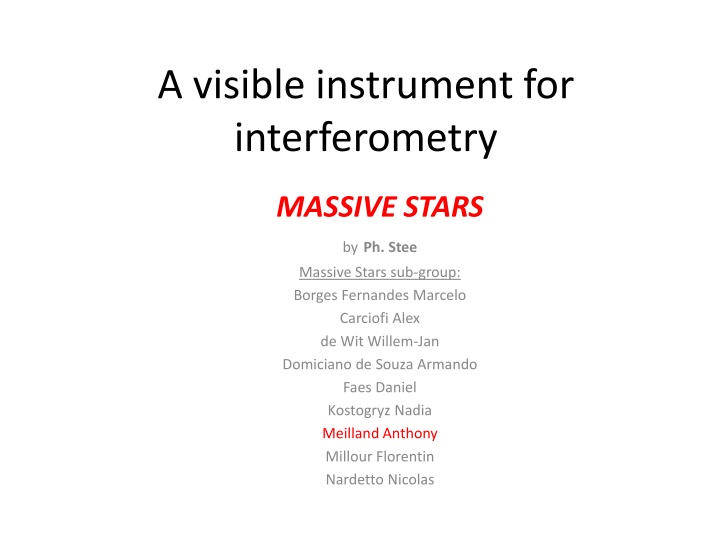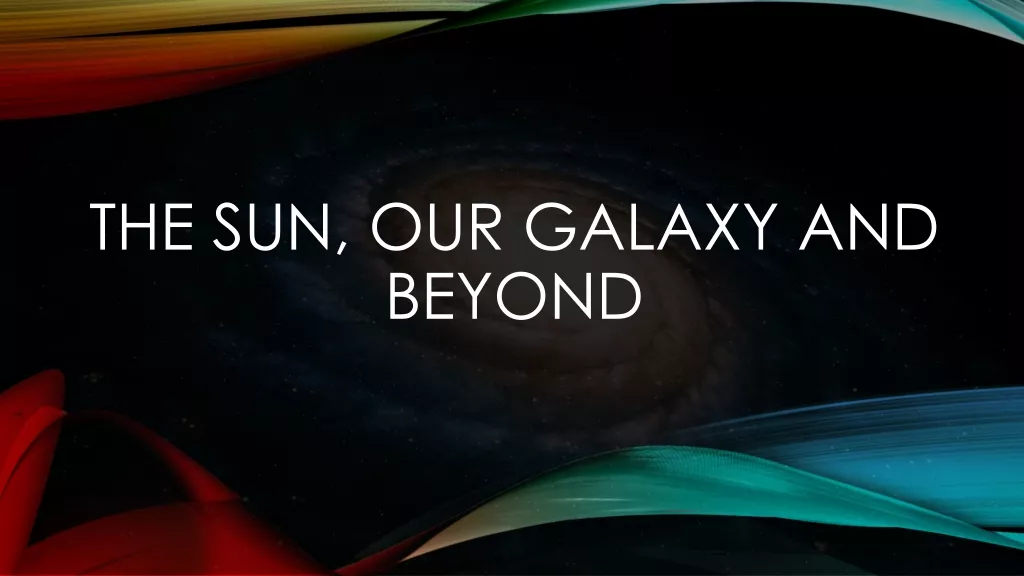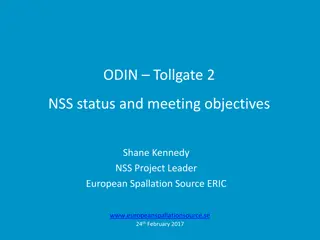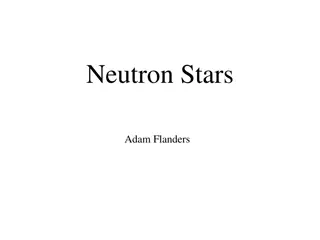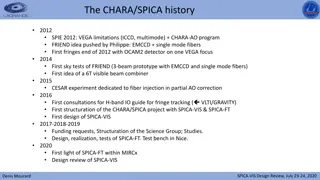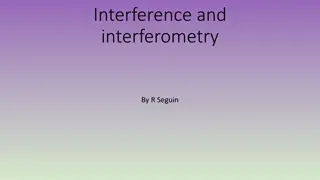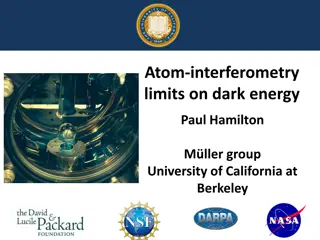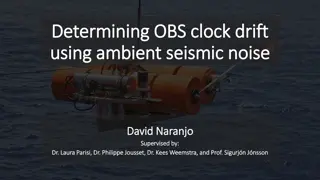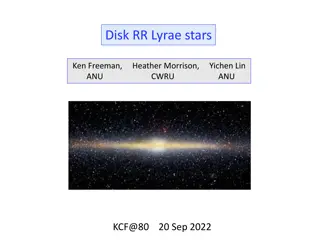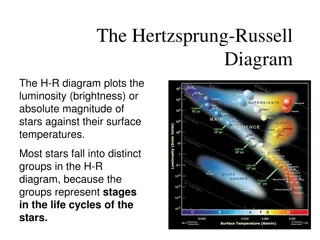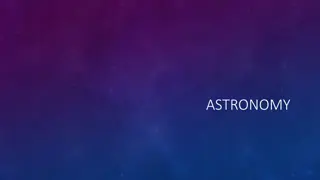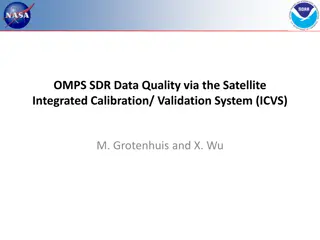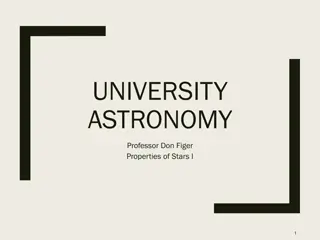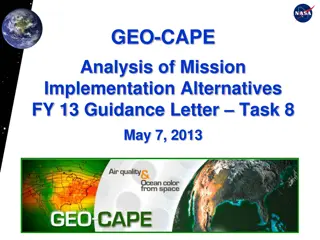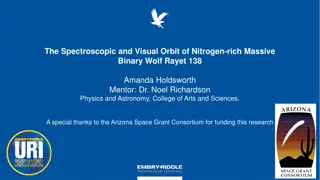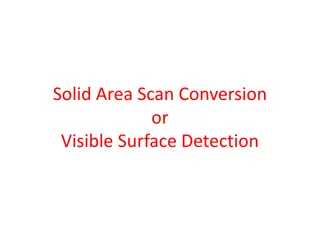Visible Instrument for Interferometry in Massive Stars Study
This collection of images and data explores various aspects of Massive Stars, including topics like stellar surface studies, multiplicity, circumstellar environments, scientific production, VEGA targets, and limitations. The content delves into measurements of stellar surfaces and discusses the challenges and opportunities in studying massive stars using interferometry.
Download Presentation

Please find below an Image/Link to download the presentation.
The content on the website is provided AS IS for your information and personal use only. It may not be sold, licensed, or shared on other websites without obtaining consent from the author.If you encounter any issues during the download, it is possible that the publisher has removed the file from their server.
You are allowed to download the files provided on this website for personal or commercial use, subject to the condition that they are used lawfully. All files are the property of their respective owners.
The content on the website is provided AS IS for your information and personal use only. It may not be sold, licensed, or shared on other websites without obtaining consent from the author.
E N D
Presentation Transcript
A visible instrument for interferometry MASSIVE STARS by Ph. Stee Massive Stars sub-group: Borges Fernandes Marcelo Carciofi Alex de Wit Willem-Jan Domiciano de Souza Armando Faes Daniel Kostogryz Nadia Meilland Anthony Millour Florentin Nardetto Nicolas
Massive Stars: Topics Stellar surface studies: diameters, fast rotation, flattening, gravity darkening, differential rotation Multiplicity: Characterization of multiple systems, interactions between components Circumstellar environments: geometry and kinematics, mass flux determination, surface/disk interface
Massive Stars: Scientific production A very productive topic: 14 papers are about massive/hot stars for a total of 24 VEGA papers 10 papers on the geometry & kinematics of the circumstellar environment mainly in H (AB Aur, Deneb & Rigel, 48 Per & Per, Lyr & Sgr, Sco, Cas, Aur, HD 200775) 1 paper on a diameter measurement ( Equ) 1 paper on the geometry in the continuum ( Cep)
Massive Stars: VEGA Targets In 2013: 10 programs on VEGA were about massive stars (50%) In 2014: 9 programs among 17 (1 on multiplicity (eclipsing binaries, Aurigae, SS Lep), 4 on stellar surfaces (Bn, HD177724, HD209409, Ori) , 4 on circumstellar environments ( Ori, 51 Oph, HD141569, Hypergiants) VEGA remote observations
VEGA actual limitations Magnitude limitation (u,v) plane coverage Maximale Resolution D = 0.5 mas (B = 330 m) Limited for extended objects( > 2 mas) No compact triplet on CHARA Not possible for D > 5.5 mas (B = 30 m) V=3.5 (HR) B2V 200 pc D*= 0.25 mas Denv = 2.5 - 5 mas VEGA on CHARA Not very well optimised for the study of circumstellar environments Detector problems scaling of spectra Saturation for bright objects Filters loss of SNR Other limitations Reduced SNR in the blue No phase closure
Massive Stars: Stellar Surfaces Diameters measurements: - To constrain stellar evolution models of massive stars - To calibrate the surface-brightness relation (distance in the Universe) Magnitude limitation ? Spatial resolution problem ? Spec. T B Lum. Cl. mV=5 mV=6 mV=7 For a B2V mV=5 mV=6 mV=7 IV-V 260 683 1460 Distance 400pc 600pc 1000pc III 76 185 383 Diameter 0.13mas 0.08mas 0.05mas I-II 57 165 549 B (V=0.9 =0.6) 270m 440m 700m IV-V 5 13 18 B (V=0.5 =0.6) 660m 1080m 1730m O III 4 5 8 B (V=0.9 =0.4) 180m 300m 470m I-II 4 11 21 B (V=0.5 =0.4) 440m 720m 1150m NO !!! YES !!! Solutions Longer baselines Shorter wavelengths Better precision
Massive Stars: Stellar Surfaces Fast rotation: photosphere flattening Ex : Achernar flattening Domiciano de Souza et al. (2003) Measurements in the continuum Spectral resolution: No No resolving baselines Visibility < 0.8 Maximum baselines Multiple measurements Spec. Cl. Diam. Dist max Nb * B9 IV-V 2.7 Ro 150 pc 131 B5 IV-V 3.9 Ro 210 pc 33 B2 IV-V 5.6 Ro 300 pc 51 O9 IV-V 7.9 Ro 450 pc 96 Obs. with CHARA (B=330m pour V<0.8 D>0.15mas)
Massive Stars: Stellar Surfaces Fast rotation: gravitational darkening Alpha Cep Alta r Zhao et al. (2009) Monnier et al. (2007) Measurements in the continuum or in lines Spectral resolution: No Resolving baselines(V ~ 0) Second visibility lobe Large Baselines Phase closure Image Reconstruction + model-fitting Spec. Cl Diam. Dist max Nb * B9 IV-V 2.7 Ro 50 pc 7 B5 IV-V 3.9 Ro 70 pc 2 B2 IV-V 5.6 Ro 100 pc 3 O9 IV-V 7.9 Ro 150 pc 1 Obs. on CHARA (B=330m D>0.5mas)
MASSIVE STARS: Stellar Surfaces Fast rotation: differential rotation & gravitational darkening In photospheric lines In the continuum Degeneracy between et Delaa et al. (2013) Multiple baselines per target Precision on the phase of degres Spec. Cl. Diam. Dist max Nb * B9 IV-V 2.7 Ro 50 pc 7 B5 IV-V 3.9 Ro 70 pc 2 Rmin= 10000 (Ropt= 20000) B2 IV-V 5.6 Ro 100 pc 3 Limited by the spatial resolution ! O9 IV-V 7.9 Ro 150 pc 1 Obs on CHARA (B=330m D>0.5mas et mV<4)
Massive Stars: Stellar activity Pulsations Magnetism Stellar Spots ? Direct measurement ? Importance of NRP in the Be phenomenon Indirect measurement by the effect on the circumstellar environment Measurement in photospheric lines Yes If convective zone due to fast rotation S/N = 100 R > 15000 20km/s Detectable ? Indirect measurement in emission lines
Massive Stars: circumstellar environments Out of the H line Visible Spectrum of the classical Be star Alpha Arae Acces to faint lines Precision <1% on diff. Vis. Towards the blue domain Atmospheric turbulence
Massive stars: image reconstruction Difficulities: phase closure Small vivibilities HD62623 : 3 nights with AMBER In the V band the CE of masive stars are generally: In the continuum: Flux dominated by the central star Need high precision for the measurements (1%) Millour et al. 2011 In the emission lines: Continuum calibration mostly unresolved Auto- Nb de tel. 3T 4T 5T 6T 7T Temps d obs 3n 1.5n 1n 0.6n 0.4n
Massive Stars: circumstellar environments Many objects: - Classical Be stars - Supergiants and unclassified B[e] - B & A supergiants - Yellow hypergiants - Wolf-Rayet - Novae
Massive stars: classical Be stars Cas Objectives : Kinematics within different spectral lines Link photosphere environment Be-Shell i~90 disk opening angle Polar winds ? Statistical studies Variability (Pulsation & Binarity) Modeling : ionization, Temperature, density Needs : Rmin= 1500 200 km/s Ropt= 15000 20 km/s Short baselines (20-50m) High precision for the visibilities : 1-2% Faint visibilities (lines) Magnitude is not a problem ! mV 3 4 5 6 Nb of Stars 11 23 59 102 Stee et al. 2012 Fr mat et al. 2005
Massive stars: B[e] Objectives : Determine where the spectral lines are formed Kinematics (disks vs winds) Objects classification (young/evolved/binaries) Variability (images as a function of time) Needs : Rmin= 1500 200 km/s Ropt= 15000 20 km/s Objects mostly faint in V HD62623 mV 5 7 9 Nb of stars 1 4 10 But non exhaustive list of targets Millour et al. 2011
Massive stars: Corotating-Interacting regions Pole-on view Owocki, Cranmer and Fullerton, 1995 Harries et al. 1995 Origin of these perturbations? - Anchored magnetic fields - Non-Radial pulsations +perturbation by fast rotation Dessart & Chesneau 2002
Massive stars: B & A supergiants Objectives : Diameters measurements Extension in H (and other lines) Mass loss Asymmetry & time evolution Problems : Over-resolved with CHARA/VEGA Solutions : Concentrate on stars @ larger distances Smaller baselines Chesneau et al. 2010
Massive stars: Yellow hypergiants Objectives: Constrain the geometry in the continuum Study the instabilities in the atmosphere (spectral lines) Constrain the rotation (pseudo-photosphere) Companions detection and spectrum disentangling Needs : R = 30000 10km/s mV = 5 (8) A least 2 targets identified (Nord hemisphere): Cas HR 8752 + 2 objets with mV < 8 + 5 in the South hemisphere HR5191 Chesneau et al. (2014) D=3.6kc, UD=3.6mas! R*=1380 Rsol
Massive stars: Wolf Rayet Objectives : Extension in spectral lines Probing the ionization structure Modeling the mass loss(Hillier & Dessart) Study the binarity Needs : Large spectral lines R = 1500 200 km/s Objects faint in the visible (mV = 8) Numerous and very bright emission lines V=5.4 WR 140 mV=6.9
Massive stars: Wolf Rayet 6 gain (2 mag) WR 137 V=6.4 4 Cont. V=7.9 Amateur spectrum
Massive stars: Novae T Pyx observed withAMBER Bright targets during a short period of time Strong lines in emission Rapid evolution of the circumstellar environment Strong asymmetries developing V373 Scuti 6 mag 1970 FH Serpentis 4 mag 1975 V1500 Cygni 2.0 mag 1975 1976 NQ Vulpeculae 6 mag Reactivity + large number of baselines spectro- imaging 1984 QU Vulpeculae 5.2 mag 1978 V1668 Cygni 6 mag 1986 V842 Centauri 4.6 mag 1991 V838 Herculis 5.0 mag Spectral resolution needed: at least 1500 200km/s 1992 V1974 Cygni 4.2 mag In 37 years 1999 1999 V1494 Aquilae 5.0 mag 13 novae with mV<6 4 novae with mV<4 4.5 mag V382 Velorum 2.6 mag 2006 RS Ophiuchi 2007 V1280 Scorpii 3.7 mag mV=8 1 nova / per year for VEGAS Chesneau et al. 2011
Massive stars: multiplicity Why ? 1 mas Study of multiple systems provides accurate masses Constraints on the formation of massive stars ? How ? Hierarchical triple system Tau Orbits: 7 & 145 days Need long and short baselines simultaneously => Image is a must have ! Super-synthesis effect thanks to spectral resolution Many targets up to V = 7
Massive stars: interaction Images MIRC de Lyr X-Ray Be-binaries : Prototype Lyr D = 1 mas T = 12.9 jours - Perfectly suited for imaging with 300m baselines - First convincing studies in the lines with VEGA - First image with MIRC Images in Continuum + Lines (H , H & HeI) Companion deformation Spatial geometry of the ionized gaz Gas kinematics Physical conditions for the CE (T, , ni) Constraints on the mass loss Other similar objects possible Zhao et al. 2008
Massive stars: global specifications Spectral modes : 2, 3 ou 4 HR1 HR2 MR LR : R=30000-40000 7-10 km/s : R=10000-15000 : R=2000-5000 : R<500 Pulsations, rotation, supergiants rotation Fast Rotation, disks & winds 60-150 km/s Wolf-Rayet, spectro faint CE X Stellar diameters, reddened sources 20-30 km/s Sensibility : Measurements accuracy: mV = 5 for HR1 mV = 7 for HR2 mV = 9 for MR mV = ? LR Faint visibilities (stellar surfaces) v= few % in the continuum (Cont. Env.) v= few 0.1% in lines (Pulsations) = 1 in lines (Rotation/Pulsation) Phase closure constraints Number of telescopes: At least 5 telescopes for 1 image/night Short baselines mandatory (20-30m) and large (>300m) depending on the science objectives.
Where ? CHARA VLTI Many short baselines (10-50m) Large telescopes 8.2m (UT) AT 1.6m = 1 more mag compared to CHARA Many large baselines (330m) Flexible organization 2 small baselines (34m & 66m) Fixe telescopes Only small telescopes Stellar surfaces Maximum number of 4 telescopes No large baselines ( > 200 m ) ESO organization ;-) vs Circumstellar environments
MROI ? 9 movable telescopes (1.4 m) 28 stations Baselines from 8 to 340 m Large or compact configurations possible
